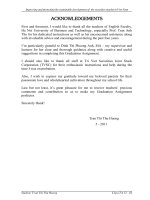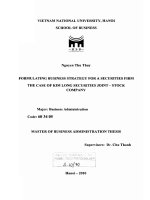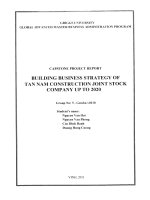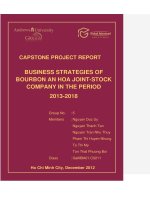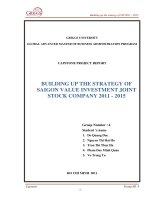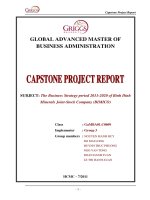THE GRADUATION THESIS ANALYSE AND PROPOSE SOLUTIONS TO IMPROVE ONLINE MARKETING ACTIVITIES OF VDATA DIGITAL MEDIA JOINT STOCK COMPANY
Bạn đang xem bản rút gọn của tài liệu. Xem và tải ngay bản đầy đủ của tài liệu tại đây (2.4 MB, 84 trang )
MARKING SHEET
1. BY THE SUPERVISOR:
In number:
In word:
Signature
In word:
Signature
Special remarks (if any):
2. BY THE REVIEWER:
In number:
Comments:
2|P ag e
TABLE OF CONTENTS
LIST OF FIGURES ...................................................................................................4
LIST OF TABLES .....................................................................................................5
LIST OF ABBREVIATIONS & ACRONYMS.......................................................6
ACKNOWLEDGEMENTS .......................................................................................7
INTRODUCTION ......................................................................................................8
CHAPTER 1 ............................................. LITERATURE REVIEW OF ONLINE
MARKETING ..........................................................................................................10
1.1
Marketing overview ....................................................................................10
1.1.1
Marketing definition ............................................................................. 10
1.1.2
The role of marketing ........................................................................... 10
1.2
Online marketing overview .......................................................................10
1.2.1
Marketing online definition .................................................................. 10
1.2.2
Characteristics of online marketing ...................................................... 11
1.2.3
Forms of online marketing .................................................................... 12
1.2.4
Benefits of Online marketing ................................................................ 13
1.3
Online marketing in business activities of the enterprise .......................13
1.3.1
Analyze the marketing environment ..................................................... 13
1.3.2
Market segmentation and target market ............................................... 15
1.3.3
Market positioning ................................................................................ 18
1.3.4
7Ps marketing policy ............................................................................ 19
1.3.5
Tools of Online marketing .................................................................... 21
1.3.6
Methods for determining a marketing budget ...................................... 24
1.3.7
Evaluate online marketing activities ..................................................... 25
CHAPTER 2 ....................................................... ANALYSIS OF THE CURRENT
ISSUES
28
2.1
Introduction to the company .....................................................................28
2.1.1
The history of the company's foundation ............................................. 28
2.1.2
Mission and Objectives ......................................................................... 28
2.1.3
Organization structures ......................................................................... 29
2.1.4
Main product and services .................................................................... 30
1|P ag e
2.2
The business situation of VDATA company in recent years ..................30
2.3 Factors affecting the online marketing policy of VDATA digital media
joint-stock company ..............................................................................................32
2.3.1
Macro environment analysis ................................................................. 32
2.3.2
Industry environment analysis .............................................................. 34
2.3.3
Main competitors .................................................................................. 34
2.3.4
Internal environment ............................................................................. 36
2.3.5
Comments ............................................................................................. 37
2.4 The situation of online marketing activities at VDATA digital media
joint-stock company ..............................................................................................38
2.4.1
VDATA marketing targets ................................................................... 38
2.4.2
Market targets ....................................................................................... 39
2.4.3
Position the product on the target market ............................................. 41
2.4.4
The situation of online marketing activities of VDATA (Model 7Ps) . 41
2.4.5
Marketing tools at VDATA .................................................................. 53
2.5
Evaluating the situation of deploying online marketing tools at VDATA
53
2.5.1 The situation of online marketing activities of VDATA company
through customer reviews (questionnaire) ......................................................... 53
2.5.2
Evaluating the situation of deploying online marketing at VDATA .... 58
2.5.3
The general evaluation of online marketing activities of businesses ... 63
2.5.3
Factors affecting the online marketing activities of the company .... 64
2.6 Advantages, disadvantages and limited causes of online marketing
activities .................................................................................................................66
CHAPTER 3 ........................................................................................... PROPOSED
SOLUTIONS ............................................................................................................68
3.1
Foundations for building online marketing policies at VDATA ............68
3.1.1
VDATA's marketing targets in the period of 2020-2021 ..................... 68
3.1.2
VDATA's online marketing targets ...................................................... 68
3.2
VDATA market analysis ............................................................................68
3.2.1
Market segmentation............................................................................. 68
3.2.2
Identify the target market ...................................................................... 68
3.2.3
Position the product on the target market ............................................. 68
2|P ag e
3.3
Solutions to build media messages for the period 2020-2021 .................68
3.4
Solution for media online channels and tools from 2020 to 2021 ...........69
3.4.1
Building an interactive on Facebook .................................................... 69
3.4.2
Building VDATA's youtube channel .................................................... 69
3.4.3
Advertise online on digital sites ........................................................... 69
3.4.4
Optimize the main website of the company and build more web sitenize
69
3.4.5
Search engine optimization SEO, SEM ................................................ 70
3.4.6
Email Marketing ................................................................................... 71
3.4.7
Public relations ..................................................................................... 71
3.4.8
Promotion .............................................................................................. 71
3.4.9
Personal sales ........................................................................................ 71
3.5
Proposal for budget and KPIs from 2020 to2021 ....................................71
3.6
Marketing solutions complementing online marketing activities ..........74
3.6.1
Product solutions................................................................................... 74
3.6.2
Price solutions ....................................................................................... 74
3.6.3
Solution on distribution ........................................................................ 74
3.7
Some other solutions need to be implemented .........................................75
3.7.1
Building and developing the brand of the business .............................. 75
3.7.2
Customer services ................................................................................. 75
3.7.3
Security of personal information .......................................................... 75
3.8
Petition .........................................................................................................75
3.8.1
People .................................................................................................... 75
3.8.2
Finance and facilities ............................................................................ 76
REFERENCES ................ …………………………………………………………77
ANNEXES ………………………………………………………………………...79
SUMMARY IN VIETNAMESE .............................................................................81
3|P ag e
LIST OF FIGURES
Figure 1.1:Forms of online marketing ...................................................................... 12
Figure 1.2: Main bases of segmentation ................................................................... 16
Figure 1.3: Requirements for Effective Segmentation.............................................. 17
Figure 1.4: The 7Ps marketing model ....................................................................... 20
Figure 1.5: Tools of Online marketing ...................................................................... 22
Figure 1.6: Methods for determining a marketing budget ........................................ 24
Figure 2.1: Organizational structure model .............................................................. 29
Figure 2.2: Macro environment................................................................................. 32
Figure 2.3: Internal environment............................................................................... 36
Figure 2.4: The target customer segment is VDATA's business organization ......... 40
Figure 2.5: The main interface of thuongieuweb ...................................................... 42
Figure 2.6: Website Rental Packages ........................................................................ 43
Figure 2.7: Service Price List of Vdata Domain Name Rent .................................... 44
Figure 2.8: The Price of Seo web services ................................................................ 45
Figure 2.9: The service delivery system directly to customers ................................. 46
Figure 2.10: Product promotion form of VDATA .................................................... 47
Figure 2.11: The website analytics tool .................................................................... 48
Figure 2.12: Diagram of the process provides services to customers ....................... 49
Figure 2.13: Process of handling customer feedback ............................................... 50
Figure 2.14: Source of information approaching businesses .................................... 54
Figure 2.15: Brand awareness ................................................................................... 55
Figure 2.16: Products used at the company .............................................................. 56
Figure 2.17: Media messages are impressed by customers ...................................... 56
Figure 2.18: Comment on the content ....................................................................... 57
Figure 2.19: The website interface of the company .................................................. 58
Figure 2.20: The most searched keywords displayed related to VDATA ................ 61
Figure 2.21: VDATA website rankings and traffic ................................................... 61
Figure 2.22: Articles on Fanpage sharing about products VDATA ......................... 62
Figure 2.23: These posts are more invested on Fanpage .......................................... 62
Figure 2.24: Factors affecting the online marketing activities of the company........ 65
4|P ag e
LIST OF TABLES
Table 2.1: Report on business results from 2017 to 2019 ..........................................30
Table 2.2: Competitive analysis of VDATA .............................................................34
Table 2.3: Vdata's Current Software Service Table ...................................................41
Table 2.4: Workforce structure of the company ........................................................50
Table 2.5: Normal working ........................................................................................51
Table 2.6: Holiday schedule .......................................................................................52
5|P ag e
LIST OF ABBREVIATIONS & ACRONYMS
FAQs
: Frequently Asked Questions
ZIP code
: Zone Improvement Program Code
SEM
: Search Engine Marketing
SEO
: Search Engine Optimization
MMS
: Multimedia Messaging Service
CEO
: Chief Executive Officer
KPIs
: Key Performance Indicators
IT
: Information technology
HR
: Human Resources
SMEs
: Small and medium enterprises
6|P ag e
ACKNOWLEDGEMENTS]
This thesis mirrors all the knowledge acquired during the last four years I have
dedicated to the studies at university. The path was not always the easiest, nevertheless, I
would not have been here, at the end of my studies, without all of the hard work and people
surrounding me.
I would like to express my gratitude to my supervisor professor Trong, for his valuable
guidance and feedback provided which helped me to keep on the right track during the
whole process of writing the thesis.
I would not be here without my parents to whom I would like to thank for the courage,
unconditional support and motivation they are giving me every day.
I also want to thank my friends who always have stood by my side, have given me their
honest opinion and constructive critics thanks to which I could move forward.
Lastly, I would like to thank VDATA digital media joint-stock company, and its
representatives for the opportunity to work on the real case company as well as all the
respondents taking part in the survey. I also want to thank all the professors, friends and
family members, who have been part of the journey which now, comes to an end.
-------------------------Signature of Student
7|P ag e
INTRODUCTION
1. Rationale
The foundation of the Internet has offered new advanced business transactions and
models for the world economy. Online marketing is born to adapt to this rapid development
of online business. Therefore, online marketing has been becoming a crucial part of
successful business stories in this modern technology era. Many companies have already
created competitive advantages by using this technology.
Online marketing offers businesses a transparent outlet for measuring and assessing the
performance of the company`s marketing and advertising strategies. Not to mention, it
provides a level and cost-effective playing field for the company to compete with
competitors.
Over the past three years, Vietnam has witnessed the success of social networking
forms as a new tool for businesses access to market and target customers through forms of
online marketing. The benefits of online marketing for Vietnam's business include the
ability to reach large target customers, the ability to reach potential customers all over the
world, and the ability to customize the marketing for different sectors of the target
customers...
VDATA Digital Media Joint Stock company is one of the typical companies in
Vietnam to apply business activities' online marketing and achieve success over the years.
Therefore, online marketing has been becoming a crucial part of VDATA. How does online
marketing activities of VDATA? How to create greater customer value through online
marketing?
For that reason, in this graduation thesis, I learned and researched the characteristics of
online marketing activities of VDATA and proposed a solution to improve online
marketing activities at the company.
The title of my graduation thesis topic is: “ Analyse and propose solutions to improve
online marketing activities of VDATA digital media joint-stock company”
2. Objectives
− Systematize basic theories and methods of development market and online
marketing tools to promote commerce brand, product and service of the company;
− Evaluate the benefits of using online marketing;
− Analyze the situation of online marketing activities at VDATA digital media jointstock company
− Find a suitable online marketing solution to enhance it promoting the company's
brand, products and services that help it improve its competitiveness and search
effective target market.
8|P ag e
3. Subjects and scope of the study
• Subjects
Research online marketing activities at VDATA digital media joint-stock company.
• Scope of the study
Location: Studying the situation of online marketing activities in the northern
region, especially Hanoi and neighboring provinces
Time: Analyze the situation of online marketing activities at VDATA digital
media joint-stock company (from 2018 - 2019)
Research products: Products and services related to Website, Fanpage
4. Methodology
• Research through books: The main sources of books are curriculum and reference
books, research articles, online marketing channels and plans.
• Direct investigation: Collecting information through survey sample tables,
questionnaire for comments.
• Methods of statistics, comparisons, analysis and description to assess the status of
online marketing activities of digital media joint-stock companies VDATA.
5. Research structure
My graduation thesis includes 3 chapter:
Chapter 1: Literature Review
Chapter 2: Analysis of the Current Issues
Chapter 3: Proposed Solutions
9|P ag e
CHAPTER 1
LITERATURE REVIEW OF ONLINE
MARKETING
1.1 Marketing overview
1.1.1 Marketing definition
Marketing has been diligently given definitions and practically every author has its
interpretation of the concept. However, the definition most commonly as a reference is that
of The American Marketing Association (AMA). The current definition of AMA is the
following:
“Marketing is an organizational function and a set of processes for creating,
communicating, and delivering value to customers and for managing customer
relationships in ways that benefit the organization and its stakeholders”
Hooley et al. (2001), in turn, provide the following definition:
“Marketing is the process of profitable matching organizational capabilities to
requirements of chosen customers.”
Both of the definitions are rather strategic and customer-oriented, not focusing on
operational issues, such as 4P`s of marketing (or marketing mix; product, price, place,
promotion) or marketing channels. The marketing concept argues that all areas of the firm
should be customer-oriented, all marketing activities should be integrated, and profits, not
just sales, should be the objective (Hunt and Morgan, 2001). The first argument of these
closely relates to the concept of market orientation.
1.1.2 The role of marketing
Marketing plays the role of connecting businesses and consumers to help their products
not only reach customers faster but also create customers` faith in the products. Since then,
customer loyalty has been maintained, improving the competitiveness of the business with
the competitors, creating opportunities for businesses to increase their market share and get
more profits.
1.2 Online marketing overview
1.2.1 Marketing online definition
There is no common term to describe marketing through online mediums and terms
such as hypermedia marketing, digital marketing, online marketing and e-marketing, are
used by different researchers (Dholakia, 2005). Elley and Tilley (2009) described online
marketing as online communication activity that can be in different forms and can include
different online techniques, such as Search Engine Marketing, online partnership, social
media, online advertising, email marketing. These online marketing techniques have
10 | P a g e
become vital communication tools for the marketing department of a company to promote
its websites, services and products in the online environment. [1]
Ab Hamid (2008) states that the internet offers many opportunities for companies and
it can be a useful platform for their marketing activities, such as to spread information,
attract new customers, retain existing ones and even improve relationships with existing
customers by online customer relationship management [2] .Today, most of the companies
adopted the internet as a part of their marketing communications in their marketing
strategies. According to Adegoke (2004 cited in Jensen, 2008) “online marketing
communications have grown to be an important part of a company`s promotional mix” [3].
This view is also motivated by Shankar and Batra (2009) and they state that companies are
using the online mediums as a new marketing communication channel and marketing
through the internet is growing rapidly. [4]
1.2.2 Characteristics of online marketing
- Customers can interact with the ad, can click on the ad to buy, get information about the
product or can compare this product with other products, this supplier with other suppliers
[5]...
- Help suppliers select the target customers and the potential that the business wants to help
businesses reduce costs, improve business efficiency.
11 | P a g e
1.2.3 Forms of online marketing
Figure 1.1: Forms of online marketing
Ad-network: Advertising networks provide a way for media buyers to coordinate ad
campaigns across dozens, hundreds, or even thousands of sites in an efficient manner.
The campaigns often involve running ads over a category (run-of-category) or an entire
network (run-of-network). Site-specific buys are not a major emphasis when dealing
with advertising networks. Site-specific buys are not even available at some networks,
so as not to conflict with in-house sales reps.
❖ Search Marketing: Search marketing is the process of gaining traffic and visibility
from search engines through both paid and unpaid efforts.
12 | P a g e
❖ Social Media Marketing: Social media marketing is the use of social media
platforms to connect with your audience to build your brand, increase sales, and
drive website traffic.
❖ Buzz Marketing: Buzz marketing is a viral marketing technique that is focused on
maximizing the word-of-mouth potential of a particular campaign or product,
whether that is through conversations among consumers' family and friends or
larger scale discussions on social media platforms.
❖ E-mail marketing: is a form of direct marketing that uses email to promote your
business’s products or services. It can help make your customers aware of your
latest items or offers. It can also play a pivotal role in teaching folks about your
brand or keeping them engaged between purchases.
1.2.4 Benefits of Online marketing
❖ The Internet gives you wide access to your potential customers. It has been
estimated that a couple of billion people around the world use the Internet, and more
are becoming aware of the Internet with each passing day. So, marketing your
business to such a large group of people is only possible through the Internet.
❖ The Internet is the only medium that can cross geographic and national boundaries.
❖ The cost of promoting your business on the Internet is cheaper than other mediums
of marketing. This makes it easy for small and mid-sized businesses to advertise
their products.
❖ The Internet allows the ability to stay connected with customers on a real-time basis.
If any discount going on, then it is easier to send an email to customers and they can
buy the product instantly. The Internet also allows us to send multiple messages at
the same time, which saves the tedious task of sending a newsletter to every client.
❖ Internet marketing facilitates instant feedback from customers. Customers can share
their experiences after using the product.
❖ Internet marketing saves a lot of time and effort. Instead of having a customer
service representative to answer the queries of customers, one can put all the
information about the product or service on the Internet so that customers can go
through it. The most common way of doing it is to have a section dedicated to
frequently asked questions (FAQs) about the product so that customers get all the
required information about the product or the service.
❖ Internet marketing allows your business to be available 24/7, which means increased
sales and profits.
1.3 Online marketing in business activities of the enterprise
1.3.1 Analyze the marketing environment
The Marketing Environment includes the Internal factors (employees, customers,
shareholders, retailers & distributors, etc.) and the external factors (political, legal, social,
13 | P a g e
technological, economic) that surround the business and influence its marketing
operations.
❖ Macro marketing environment
In the field of marketing, the macro environment is the set of external factors and
forces, not controlled by the company, that influence its development. It mainly includes
economic, cultural, technological, legal or political elements.
o Economic factors, as discussed above, are related to inflation, taxes,
unemployment, and the recession. While people in business can track trends and
implement planning, many businesses are not recession-proof.
o Political factors may be related to the government. They consist of legislative
bills, tax policies, health and safety laws, and government stability. The average
businessman can’t lower taxes or introduce new legislation that’ll affect the
entire economy. They must instead understand these factors on a grand level and
ensure their business aligns with laws, regulations, and policies.
o Social factors consist of people (or consumers). They buy products based on
many different factors. This includes their demographic location, ethnic
background, social status, immediate needs, lifestyle changes and trends.
o Technological factors are often referred to as advancements in technology. Not
only technology used to develop and deliver products to consumers. But also the
technology used to run businesses efficiently. The company who is fastest, with
the best agile technology, can easily out beat the competition in any market.
Keeping an eye out on which technology is used in the industry can mean life or
death for the firm.
❖ Microenvironment
Microenvironment, refers to the environment comprising of all the actors of an
organization’s immediate environment which influences the performance of the company,
as they have a direct bearing on the firm’s regular business operations.
o Suppliers are the one who provides inputs such as material, components, labour
and other stock of goods to the firm, which is required to undertake
manufacturing activities. when there is uncertainty as to the supply constraints,
it usually builds pressure on the firms and they are required to maintain high
inventories, which leads to cost increases.
o Intermediaries refer to marketing intermediaries that cover agents, merchants,
distributors, dealers, wholesalers, etc. that participate in the company’s supply
chain, in stocking and transporting the goods from their source location to their
destination.
o Customers: The success of the organization greatly depends on how effectively
the firm fulfills the needs and wants of the customers, which is profitable to the
firm and also provides value to the customer. The firm needs to analyze what the
14 | P a g e
customers expect from their products and services so that the firm can satisfy
them.
o Competitors: Competition is what keeps the firm thriving. Competitors are the
rival sellers operating in the same industry. It must be noted that the nature and
intensity of competition highly influence the firm’s products and services.
Product Differentiation is something that helps the firm to beat the cut-throat
competition in the market.
o Shareholders are the real owners of the company who invest their money in the
company’s business, by purchasing the shares, for which they are paid a
dividend every year as a return. Shareholders have the right to vote in the
company’s general meeting.
o Employees: Placing the right person at the right job and retaining them for the
long term by keeping the staff motivated is very important for the strategic
planning process. Training and development act as a guide to the firm’s
employees which ensures an up-to-date workforce.
1.3.2 Market segmentation and target market
a) Market segmentation
Market segmentation is the process of dividing a market of potential customers into
groups, or segments, based on different characteristics. The segments created are composed
of consumers who will respond similarly to marketing strategies and who share traits such
as similar interests, needs, or locations. There are various methods (or "bases") a business
can use to segment a market. However, here is a summary:
15 | P a g e
Figure 1.2: Main bases of segmentation
❖ Demographic Segmentation: Demographic segmentation is one of the most
popular and commonly used types of market segmentation. It refers to statistical
data about a group of people.
Demographic Market Segmentation, examples: age, gender, income, location,
family situation, annual income, education, ethnicity
❖ Psychographic
Segmentation:
Psychographic
Segmentation categorizes
audiences and customers by factors that relate to their personalities and
characteristics.
Psychographic Market Segmentation, examples: personality traits, values, attitudes,
interests, lifestyles, psychological influences, subconscious and conscious beliefs,
motivations, priorities
Psychographic segmentation factors are slightly more difficult to identify than
demographics because they are subjective. They are not data-focused and require
research to uncover and understand.
❖ Behavioral Segmentation
16 | P a g e
While demographic and psychographic segmentation focus on who a customer
is, behavioral segmentation focuses on how the customer acts.
Behavioral Market Segmentation, examples: purchasing habits, spending habits,
user status, brand interactions
Behavioral segmentation requires you to know about your customer’s actions. These
activities may relate to how a customer interacts with your brand or to other
activities that happen away from your brand.
❖ Geographic Segmentation: Geographic segmentation is the simplest type of
market segmentation. It categorizes customers based on geographic borders.
Geographic Market Segmentation, examples: zip code, city, country, radius around
a certain location, climate, urban or rural
Geographic segmentation can refer to a defined geographic boundary (such as a city
or ZIP code) or type of area (such as the size of city or type of climate).
Requirements for Effective Segmentation
To be useful, a market segment must be:
Figure 1.3: Requirements for Effective Segmentation
❖ Measurable: The size, purchasing power, and profiles of the segments can be
measured. Certain segmentation variables are difficult to measure.
❖ Accessible: The market segments must be effectively reached and served. Suppose a
fragrance company finds that heavy users of its brand are single men and women who
stay out late and socialize a lot. Unless this group lives or shops at certain places and is
exposed to certain media, its members will be difficult to reach.
17 | P a g e
❖ Substantial: The market segments are large or profitable enough to serve. A segment
should be the largest possible homogeneous group worth pursuing with a tailored
marketing program. It would not pay, for example, for an automobile manufacturer to
develop cars especially for people whose height is greater than seven feet.
❖ Differentiable: The segments are conceptually distinguishable and respond differently
to different marketing mix elements and programs. If men and women respond similarly
to marketing efforts for soft drinks, they do not constitute separate segments.
❖ Actionable: Effective programs can be designed for attracting and serving the
segments. For example, although one small airline identified seven market segments,
its staff was too small to develop separate marketing programs for each segment.
b) Target market
The target market is the end consumer to which the company wants to sell its end
products too. Target marketing involves breaking down the entire market into various
segments and planning marketing strategies accordingly for each segment to increase the
market share.
❖ Evaluating market segments:
o Segment size and growth
• Smaller versus larger segments
• Growth potential
o Segment structural attractiveness
• Competition
• Substitute products
• Power of buyers
• Power of suppliers
o Company objectives and resources
• Competitive advantage
• Availability of resources
• Consistent with company objectives
1.3.3 Market positioning
❖ Definition
• “Positioning is the act of designing the company`s offering and image to occupy
a distinct place in the target`s mind” (Philip Kotler)
❖ Types of positioning strategies
• Product attributes and benefits: Associating your brand/product with certain
characteristics or with certain beneficial value
• Price and quality: Associating your brand/product with competitive pricing/
high quality
• Use and application: Associating your brand/product with a specific use
• Product class: Positioning by product class is a marketing strategy that consists
of promoting two products that lie in the same product class. By promoting
18 | P a g e
two related products simultaneously, the positioning of both is improved in
the market. The main driver of positioning by product class is usually sales
promotions and sales tactics.
• Product user: This deals with positioning a product keeping in mind a specific
user or a class of users. Cosmetics brands like Revlon, L’Oreal or Lakme
position themselves targeting fashion-conscious women.
• Competitor: Making consumers think that your brand/product is better than
your competitors
• Cultural symbols: Culture plays a very important role in society today. Thus,
many brands as well as products have started positioning by cultural symbols
and cultural values to set them apart from the competition.
❖ Select and implement a positioning strategy
Enterprises need to determine what is the difference from competitors
• Differentiated products
• Differentiated services
• Differentiated people
• Differentiated distribution channel...
❖ Media for positioning strategy
The media plan for the positioning strategy to the target market is designed to convey
the positioning strategy to the target market.
The tasks of positioning include:
✓ Detect differences
✓ Apply criteria that select the most important differences
✓ Creating effective signals for the target market to distinguish itself from
competitors.
1.3.4 7Ps marketing policy
The marketing mix is a key foundation on which most modern marketing strategies
and business activities are based.
19 | P a g e
Figure 1.4: The 7Ps marketing model
❖ Product: Kotler and Armstrong (2010) said, product means the goods-and-services
combination the company offers to the target market. For many a product is simply
the tangible, physical item that we buy or sell. You can also think of the product as
intangible i.e a service. [6]
❖ Price: Kotler and Armstrong (2007) said, price is the amount of money customers
have to pay to obtain the product [7]. Išoraitė (2016) argued that “price is perceived
as the only element of the marketing mix, generating revenue and the most
important customer satisfaction and loyalty factor” [8]. The company`s goal in
terms of price is really to reduce costs through improving manufacturing and
efficiency, and most importantly the marketer needs to increase the perceived value
of the benefits of its products and services to the buyer of the consumer.
❖ Place: Service distribution through physical and non-physical channels (7P’s: A
Literature Review of Islamic Marketing and Contemporary Marketing Mix
2014).Kotler and Armstrong (2010) argued that “Place includes company activities
that make the product available to target consumers.” The place is also known as
channel, distribution, or intermediary. It is the mechanism through which goods
and/or services are moved from the manufacturer/service provider to the user or
consumer. [6]
❖ Promotion: Promotion is an activity that highlights the products or services to
customers (Nuseir & Madanat, 2015) [9]. Marketing communication mix
(Promotion mix) consists of the specific blend of advertising, personal selling, sales
promotion, public relations and direct marketing tools that the company uses to
pursue its advertising and marketing objective (Kotler 2007) [10]. The previous
20 | P a g e
studies also show the linkage between promotion and customer satisfaction (Bawa
et al., 2013; Kadhim et al., 2016; Wahab et al., 2016; Verma and Singh, 2017;
Alipour et al., 2018). [11] [12] [13] [14]
❖ People: Zeithaml et al (2008) argued that “ all human actors who play a part in
service delivery and thus influence the buyer`s perceptions; namely, the firm`s
personnel, the customer, and other customers in the service environment.” People
are the most important element of any service of experience. Services tend to be
produced and consumed at the same moment, and aspects of the customer
experience are altered to meet the individual needs of the person consuming it. [15]
❖ Physical environment: Zeihaml et al (2008) said physical evidence is...The
environment in which the service is delivered, and where the firm and customer
interact, and any tangible components that facilitate performance or communication
of the service.” Physical Evidence is the material part of a service. Strictly speaking,
there are no physical attributes to a service, so a consumer tends to rely on material
cues. There are many examples of physical evidence, including some of the
following buildings, equipment, signs and logos, annual accounts and business
reports, brochures, your website, and even your business cards. [15]
❖ Process: Zeithaml et al (2008) argued that “the actual procedures, mechanisms, and
flow of activities by which the service is delivered – this service delivery and
operating systems. There are several perceptions of the concept of process within
the business and marketing literature. Some see processes as a means to achieve an
outcome, for example – to achieve a 30% market share a company implements a
marketing planning process. However, in reality, it is more about the customer
interface between the business and consumer and how they deal with each other in
a series of steps in stages, i.e. throughout the process. [15]
1.3.5 Tools of Online marketing
21 | P a g e
Figure 1.5: Tools of Online marketing
❖ Search Engine Marketing (SEM) - Search Engine Marketing, or SEM, is designed
to increase a website's visibility in search engine results pages (SERPs). Search
engines provide sponsored results and organic (non-sponsored) results based on a
web searcher's query. Search engines often employ visual cues to differentiate
sponsored results from organic results. Search engine marketing includes all of an
advertiser's actions to make a website's listing more prominent for topical keywords.
❖ Email Advertising - Email advertising is ad copy comprising an entire email or a
portion of an email message. Email marketing may be unsolicited, in which case the
sender may give the recipient an option to opt-out of future emails, or it may be sent
with the recipient's prior consent (opt-in).
❖ Web banner advertising - Web banners or banner ads typically are graphical ads
displayed within a web page. Banner ads can use rich media to incorporate video,
audio, animations, buttons, forms, or other interactive elements using Java applets,
HTML5, Adobe Flash, and other programs.
❖ Frame ad (traditional banner) - Frame ads were the first form of web banners.
The colloquial usage of "banner ads" often refers to traditional frame ads. Website
publishers incorporate frame ads by setting aside a particular space on the web page.
22 | P a g e
❖ Pop-ups/pop-unders - A pop-up ad is displayed in a new web browser window that
❖
❖
❖
❖
❖
opens above a website visitor's initial browser window. A pop-under ad opens a new
browser window under a website visitor's initial browser window.
Floating ad - A floating ad, or overlay ad, is a type of rich media advertisement that
appears superimposed over the requested website's content. Floating ads may
disappear or become less obtrusive after a preset period.
Expanding ad - An expanding ad is a rich media frame ad that changes dimensions
upon a predefined condition, such as a preset amount of time a visitor spends on a
webpage, the user's click on the ad, or the user's mouse movement over the ad.
Expanding ads allow advertisers to fit more information into restricted ad space.
xvii Interstitial ad - An interstitial ad displays before a user can access requested
content, sometimes while the user is waiting for the content to load. Interstitial ads
are a form of interruption marketing. Text ads - A text ad displays text-based
hyperlinks. Text-based ads may display separately from a web page's primary
content, or they can be embedded by hyperlinking individual words or phrases to
the advertiser's websites. Text ads may also be delivered through email marketing
or text message marketing.
Search Engine Optimization (SEO) -Search Engine Optimization, or SEO,
attempts to improve a website's organic search rankings in SERPs by increasing the
website content's relevance to search terms. Search engines regularly update their
algorithms to penalize poor quality sites that try to game their rankings, making
optimization a moving target for advertisers. Many vendors offer SEO services.
Sponsored search - Sponsored search (also called sponsored links or search ads)
allows advertisers to be included in the sponsored results of a search for selected
keywords. Search ads are often sold via real-time auctions, where advertisers bid on
keywords. xviii Social media marketing - Social media marketing is a commercial
promotion conducted through social media websites. Many companies promote
their products by posting frequent updates and providing special offers through their
social media profiles
Mobile Advertising - Mobile advertising is ad copy delivered through wireless
mobile devices such as smartphones, feature phones, or tablet computers. Mobile
advertising may take the form of static or rich media to display ads, SMS (Short
Message Service) or MMS (Multimedia Messaging Service) ads, mobile search ads,
advertising within mobile websites, or ads within mobile applications or games
(such as interstitial ads, “advergaming,” or application sponsorship).
Display advertising - Display advertising conveys its advertising message visually
using text, logos, animations, videos, photographs, or other graphics. Display
advertisers frequently target users with particular traits to increase the ads' effect.
23 | P a g e
1.3.6 Methods for determining a marketing budget
There are four primary methods for determining the marketing budget. Here they are,
starting with the most widely used method, the percentage of revenue:
Figure 1.6: Methods for determining a marketing budget
•
•
•
Percentage of revenue – The marketing budget is derived as a percentage of the
overall organization’s expected revenue for the fiscal year.
Competitive comps – The marketing budget is derived by estimating the
competition`s spend. This task is easier to perform for public companies, which
must disclose how much money they spend on sales and marketing.
Activity-based – This bottom-up approach begins with the organization’s revenue
number and works backward. The budget is calculated based on how many leads
are needed to hit the number. In addition to lead-acquisition costs, other expenses,
24 | P a g e


